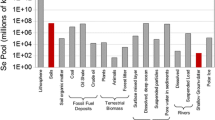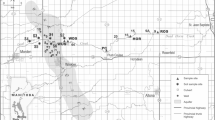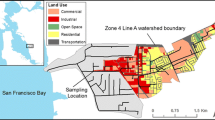Abstract
A field study was conducted on a small urban watershed (residential and golf course dominated) in southern Nevada to assess the concentration and speciation of selenium (Se) in a series of drain lines and monitoring wells and to quantify the mass discharge of Se from the drain system. Water samples were collected on a monthly basis and analyzed for total Se, selenate (SeO4 =) and selenite (SeO3 =). In addition, where possible, flow was assessed as was, temperature, redox potential, pH, dissolved oxygen (DO) along with all major cations and anions. The data were then modeled with PhreeqC to identify selenium speciation. Results revealed a SeO4 = dominated system with SeO4 = concentrations ranging from 13 to 62 ppb. In the monitoring wells, 66 % of the variation in the total Se concentration could be described based on depth to groundwater, temperature and sulfate concentrations (P < 0.001). In particular, higher total Se concentrations were predicted for shallower depth to groundwater, suggesting the solubilization of Se evapo-concentrates near the surface could be reduced by lowering water tables. The highest of all correlations was found between SeO4 = concentrations (↑) and the sodium (↑) and DO (↑) concentrations in the monitoring wells (R 2 = 0.77, P < 0.001). An excellent curvilinear relationship was found between total Se and the electrical conductivity in the water (R 2 = 0.73, P < 0.001). Based on the Se data and time line identified in this study, high concentrations of Se could be expected to drain from this area for many years to come, with salinity acting as a good proxy for Se concentration. In the drain lines, Se concentrations were found to be invariant to flow (P > 0.05). Flow discharge from the main drain system to the Las Vegas Wash was estimated at 559 acre feet during the 1 year study period. This flow was estimated to carry 4,203 Mg of salts 6.71 Mg of nitrate-N and 27.1 kg of total Se.










Similar content being viewed by others
References
Adhikari, A. R., Acharya, K., Shanahan, S. A., & Zhou, X. (2011). Removal of nutrients and metals by constructed and naturally created wetlands in the Las Vegas Valley, Nevada. Environ Monit Assess, 180, 97–113.
Allen, R. G., Pruitt, W. O., Wright, J. L., Howell, T. A., Ventura, F., & Snyder, R. (2006). A recommendation on standardized surface resistance four hourly calculation of reference ETo by the FAO 56 Penman-Monteith method. Agric. Water Manage, 81, 1–22.
Bailey, T. T., Hunter, W. J., & Gates, T. K. (2012). The influence of nitrate on selenium in irrigated agricultural groundwater systems. J Environ Qual, 41, 783–792.
Cong, W., Zhang, A., & Feng, Y. (2011). Transport of selenium and its modeling through one dimensional saturated soil columns. African J of Agric Res, 6(8), 2002–2009.
Dean, D. E., Devitt, D. A., Verchick, L. S., & Morris, R. L. (1996). Turfgrass quality, growth and water-use as a function of salinity and water deficit induced stress. Agronomy J, 88, 844–849.
Deverel, S. J., & Milliard, S. P. (1988). Distribution and mobility of selenium and their trace elements in shallow ground water of Western San Joaquin Valley. Environ Sci Technol, 22(6), 697–702.
Devitt, D. A., Morris, R. L., & Bowman, D. C. (1992). Evapotranspiration, crop coefficients, and leaching fractions of irrigated desert turfgrass systems. Agronomy Journal, 84, 717–723.
Devitt, D. A., Bowman, D. C., Lockett, M., Morris, R. L., & Wright, L. (2008). Nitrate-N concentrations in the soil solution below reuse irrigated golf course fairways. HortScience, 43(7), 2196–2202.
Devitt, D.A., Wright, L., and Young, M.H. 2013. Water and salt status of bare soil and turfgrass systems irrigated with recycled water in an arid environment. Agronomy Journal (In Press).
Engberg, R. A., Westcot, D. W., Delamore, M., & Holz, D. D. (1998). Federal and state perspectives on regulation and remediation of irrigation-induced selenium problems. Pages 1-25. In W. T. Frankenberger Jr. & S. Benson (Eds.), Selenium in the environment. New York NY: Marcel Dekker.
Frankenberger, W. T., & Engberg, T. A. (1998). Environmental chemistry of selenium. New York NY: Marcel Dekker.
Gates, T. K., Cody, B. M., Donnelly, J. P., Herting, A. W., Bailey, R. T., & Price, J. M. (2009). Assessing selenium contamination in the irrigated stream-aquifer system of the Arkansas River. Colorado. J. Environ. Qual, 38, 2344–2356.
Korom, S. F. (1992). Natural denitrification in the saturated zone. A review. Water Resour. Res, 28, 1657–1668.
Leinaeur, B., & Devitt, D. A. (2013). Irrigation science and technology. In J. C. Stier, B. P. Horgan, & S. A. Bonos (Eds.), Turfgrass: Biology. American Society of Agronomy: Use and Management.
Lemly, A. D. (1999). Selenium transport and bioaccumulation in aquatic ecosystems: a proposal for water quality criteria based on hydrological units. Ecotoxicol Environ Saf, 42, 152–156.
Lemly, A. D. (2002). Selenium assessment in aquatic ecosystems: A guide to hazard evaluation and water quality criteria. New York, USA: Springer.
Lemly, A. D. (2004). Aquatic selenium pollution is a global environmental safety issue. Ecotoxicol. Enviorn. Saf, 59, 44–56.
Masscheleyn, P. H., Delaune, R. D., & Patrick, W. H. (1989). Transformations of selenium as affected by sediment oxidation-reduction potential and pH. Environ Sci Tech, 24, 91–96.
Masscheleyn, P. H., Delaune, R. D., & Patrick, W. H. (1991). Arsenic and selenium chemistry as affected by sediment redox potential and pH. J Environ Qual, 20, 522–527.
Maxey, G.B., and Jameson, C.H. 1948. Geology and Water resources of Las Vegas, Pahrump and Indian Springs Valleys, Clark and Nye County, Nevada, State of Nevada: Office of the State Engineer, Water Resources Bulletin No 5, Carson City NV.
Mirbagheri, S. A., Tanji, K. K., & Rajaee, T. (2008). Selenium transport and transformation modeling in soil columns and ground water contamination prediction. Hydrological Processes, 22, 2475–2483.
Naftz, D. L., See, R. B., & Ramirez, P. (1993). Selenium source identification and biogeochemical processes controlling selenium in surface waters and biota, Kendrick Reclamation Project, Wyoming, U.S.A. Appl. Geophys J Roy Astron Soc, 8, 115–126.
Noack, R. E. (1988). Sources of ground water recharging the principle alluvial aquifers in Las Vegas Valley. NV, May: Nevada. Unpublished thesis submitted to the University of Nevada Las Vegas.
Ohlendorf, H.M., and Santolo, G.M. 1994. Kesterson Reservoir: Past, present and future: an ecological risk assessment. In: Frankenberger, W.T., Jr. and Benson, S. (eds.) Selenium in the Environment. P 69–117.
Parkhurst, D.L., and Appelo, C.A.J. 1999. User’s guide to PHREEQC (ver. 2)—A computer program for speciation, batch-reaction, one-dimensional transport, and inverse geochemical calcu-lations. USGeol. Surv. Water-Resources Invest. Rept.: 99–4259.
Pollard, J., Cizdziel, J., Stave, K., & Reid, M. (2007). Selenium concentrations in water and plant tissues of a newly formed arid wetland in Las Vegas Nevada. Environ. Monit Assess, 135, 447–457.
Rodriguez, M. J. M., Rivera, V. C., & Ballesta, R. J. (2005). Selenium distribution in topsoils and plants of a semi-arid Mediterranean environment. Environ. Geochem. Hlth, 27(5), 513–519.
Séby, F., Potin-Gautier, M., Giffaut, E., Borge, G., & Donard, O. F. X. (2001). A critical review of thermodynamic data for selenium species at 25 °C. Chem Geol, 171(3–4), 173–194.
Seiler, R.L.O., Skorupa, J.P., and Peltz, L.A. 1999. Areas susceptible to irrigation-induced selenium contamination of water and biota in the western United States. U.S. Geological Survey circular 1180. U.S. Dept. Interior.
Smith, D. L., & Guitjens, J. C. (1998). Characterization of urban surfacing ground water in Northwest Henderson, Clark county. Nevada. Environ & Engineer. Geos, 4(4), 455–477.
Weres, O., Bowman, H. R., Goldstein, A., Smith, E. C., & Tsao, L. (1990). The effect of nitrate and organic matter upon mobility of selenium in groundwater and in a water treatment process. Water Air Soil Pollut, 49, 251–272.
Wright, W. G. (1999). Oxidation and mobilization of selenium by nitrate in irrigation drainage. J Environ Qual, 28, 1182–1187.
Zhou, X., Roefer, P., Zikmund, K.S., and LaBounty, J.F. 2004. Selenium concentrations in the Las Vegas Wash and its tributary waters. American Water Works Association – Water Sources Conference.
Acknowledgments
We wish to thank the Bureau of Reclamation for funding provided through assistance agreement R10AC30018 to the Southern Nevada Water Authority and the cooperation of the golf course superintendent for allowing us easy access to the golf course during the study period. We also wish to thank Michael Steiner and Renee Schofield for their assistance.
Author information
Authors and Affiliations
Corresponding author
Rights and permissions
About this article
Cite this article
Devitt, D.A., Wright, L.E., Shanahan, S.A. et al. Fate of selenium in a small urban watershed. Environ Monit Assess 186, 3181–3197 (2014). https://doi.org/10.1007/s10661-013-3609-1
Received:
Accepted:
Published:
Issue Date:
DOI: https://doi.org/10.1007/s10661-013-3609-1




